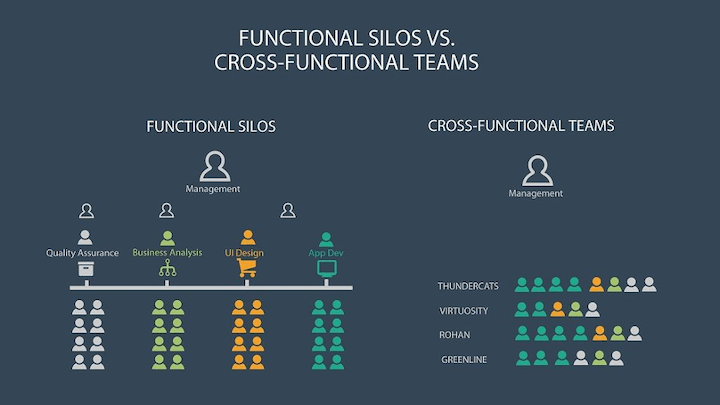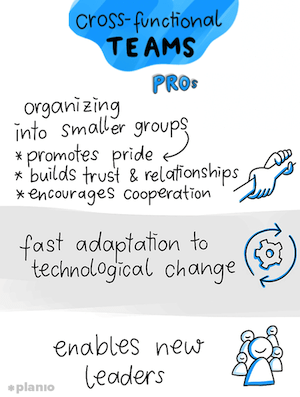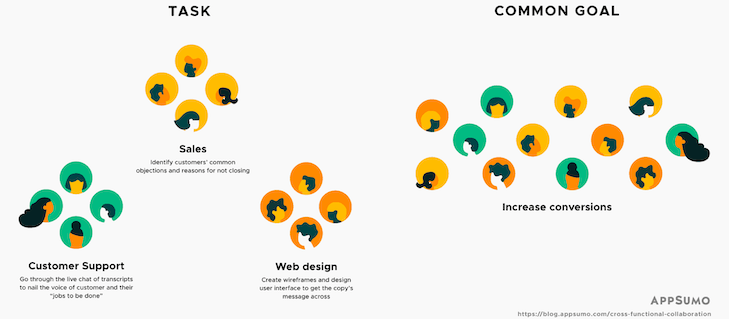Cross-Functional Collaboration - 9 Tips to Create Goal-Crushing Teams
Cross-functional collaboration is a way to create high-performance teams that have the expertise to produce the best results, no matter if it's a new product or an operational solution.

Cross-functional collaboration has many benefits. However, they can also pose challenges that could hinder their progress towards company and team goals. This guide will help you to achieve cross-functional collaboration. We'll be covering the following:
- How cross-functional collaboration looks.
- Cross-functional collaboration has many benefits
- Collaborative teams face common challenges
- Here are some tips to help you build cross-functional, high-performing teams at work.
What is cross-functional collaboration?
Cross-functional teams are essentially teams that bring together diverse skill sets in order to achieve a desired outcome. The definition of a Cross-functional Team and the desired outcome will vary depending on the company's offerings and size.
This could be:
- The start-up team consists of three members who manage development, marketing and design in order to launch the company.
- Technical SEO specialist, content writer and social media manager who works to improve online presence.
- Individuals from customer success, product, and sales working to reduce churn.
- Product, development, legal, design, marketing, sales, and PR working to launch a new product or service.
Cross-functional teams are possible of any size. The desired outcome could be the completion or achievement of long-term goals.

What are the advantages of cross-functional collaboration?
Research has shown that cross-functional collaboration can have a profound impact on businesses. Let's look at six.
Profitability increases
Did you know that connected teams experience helpful tools, but also developing communication skills, emotional intelligence, adaptability, and self-awareness. A company with well-rounded employees that are open to learning is more likely to be competitive in the market.
A stronger company culture
When we incorporate collaboration in our day-to-day, we encourage a workplace culture based on togetherness and teamwork rather than individual-mindedness. Employees have a better understanding of the perspectives and work of their coworkers.
Cross-functional teams allow employees to connect directly with other employees from other departments rather than through their managers. These individual relationships and interactions provide the setting where core values can be demonstrated and acknowledged.
Strong company culture translates into greater stability, as 37% of employees say "working with a great team" has been their primary reason for staying at an organization even when they weren't happy with their job.

Employee engagement
Participating in cross-functional work can help an individual feel valued and motivated. They get to see the company's operations firsthand, as opposed to only hearing from their manager or attending company meetings.
With visibility into how the company works as a whole toward its mission and how they contribute to it, employee loyalty wins out over employee turnover. And with hiring new talent costing businesses, on average, better leaders because it keeps them apprised of a broader range of accomplishments, challenges, and needs across the company. It also helps to develop leadership skills such as communication, integrity and interpersonal effectiveness.
This leadership skill can be learned and practiced by anyone. It can help individuals become better collaborators and prepare them for their future roles.
How can we overcome common problems of cross-functional collaboration
You can't get anything for nothing, as the old saying goes. __S.57__
1. Reaffirm goals to resolve conflicts
There will be times when people from different backgrounds, training, knowledge and goals come together. However, this does not necessarily mean that people are more concerned about their own success than the company's. This could also be a sign that different departments have different perspectives and passions, so the people who come from them may focus on different priorities.
This is a common problem. The solution to it is to keep the company's ethos and goals strong at all times. This will unify teams and ensure that every project is driven by organizational goals.
2. Keep track of everything to ensure accountability
Sometimes teamwork can create an illusion of zero accountability. Cross-functional teams sometimes lack a sense that they are responsible for the project's success. This is not productive for anyone.
To avoid the curse of no accountability, there should be one centralized location where goals and KPIs are documented, tasks are clearly listed, and owners are assigned. This could be as simple as a Google Sheet or as complex as a project management platform.
3. To build trust, encourage communication
Cross-functional teams are often formed by team members who don't know each other, have never met in person or have never worked together before. This can lead to a lack trust among the team members, not necessarily in a malicious way but subconsciously due to their lack familiarity with each other.
It will take time for them to learn to work productively alongside each other and build innate trust, but leaders must also implement a "policy" of open and honest communication and teammate acknowledgment.

4. To prevent any disjointed efforts, standardize platform use
For their daily operations, it is quite common for each department to use a different set of software. This can make it difficult for cross-departmental collaboration.
Unifying your technology solutions across the company is one way to address this problem. But, this may not be possible in every case. This is something you might consider when choosing members for your cross-functional team. In other words, try to pick people who are ready to learn and quick to adopt new tools, web apps, and software.
5. Prioritize information centralization to remote access
Remote work has become more common over the past few years. This trend has only grown since the pandemic. In fact, Forbes has revealed that by 2025 an estimated 70% of the workforce will be working remotely. This creates additional challenges for cross-functional teamwork.
Communication is more difficult than ever with individuals and whole teams working from home. This requires creative and innovative communication solutions. Employers today need to prioritise information sharing and online platforms that support as good, if not better, collaborative efforts.
How to improve cross-functional collaboration at work
It can be difficult to achieve cross-functional collaboration at work. But the rewards are well worth the effort. These are four ways to create cross-functional collaboration in your company.
6. 6.
It doesn't have to be your best performers all together.
- It is about combining all the skills necessary to reach the desired result.
- Cross-functional collaboration is a great way to encourage employee growth. However, it's important to think carefully about which personality combinations are most effective to foster this growth.
- A mix of performance levels may be a good idea in order to ensure that there is a fair distribution within a team and that low-performers are able to learn.
- It is possible that some "low performers" may not be able to use their full potential. They may be more productive if they are part of a cross-functional team.
7. Plan
A framework is essential for any collaborative effort. Make sure you have a plan and that it is thorough. The following should be included in your plan:
- Project mission:Create a larger-picture goal that inspires and motivates the team.
- The project objectivesThis is the north-start that will allow you to make the best decisions.
- Progression markersTeam members will stay on track by holding regular check-ins and meetings that serve as checkpoints.
- KPIsIndividuals will be held accountable for these tangible results.
- OwnersClear owners lead to better communication and organization.
- Expectations:If the team understands the expectations of the ultimate stakeholder, they can work together and be inspired to exceed them.

8. Incentivize performance
Leaders of cross-functional groups should not only measure progress and success using KPIs but should also reward people or teams who perform well. They may even organize a friendly competition among cross-functional teams.
9. Choose the right technology
You will need the right communication technology to enable cross-functional teams to function effectively. This includes screen sharing, video conferencing, project management apps, and VoIP solutions.
Too often, different channels and tools are used by departments for communication and operations. Cross-functional collaboration can be difficult when departments use different tools and channels. It is important to establish which channels are used for what purposes in order to keep everything running smoothly.
Get the benefits of cross-functional collaboration right now
The modern work culture emphasizes agility, flexibility, speed, and quick footedness. Teamwork is key to gaining diverse skills.
Cross-functional teamwork is not without its challenges. But the rewards can be great. Companies can harness their vast knowledge to their full potential, engage and retain staff, foster leadership and innovation, and gain a competitive edge in their markets. Take these best practices and tips to get the most out of cross-functional collaboration at work today.
Comments
Post a Comment